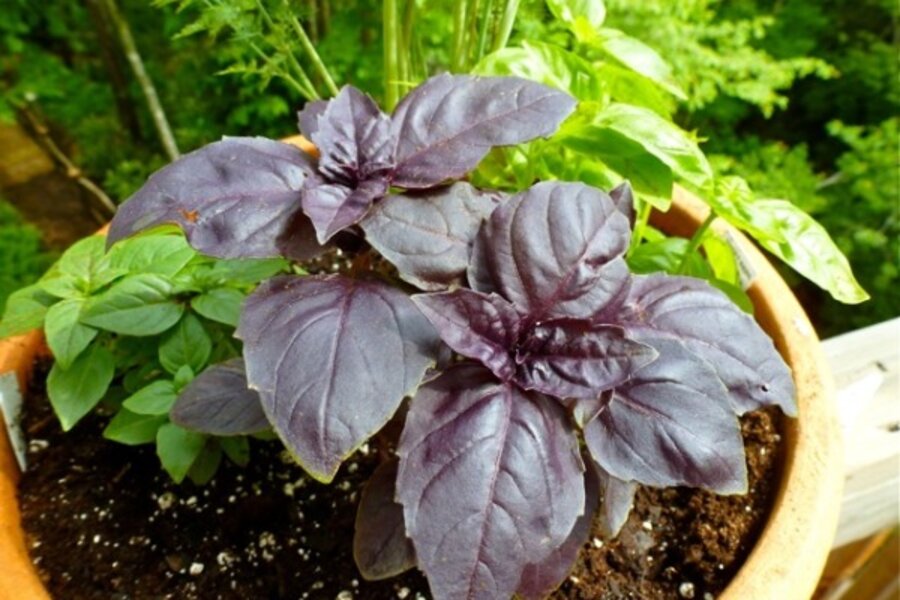Basil spices up summer gardens and recipes
Loading...
Few summer experiences are as memorable as strolling through an herb garden, brushing past Ocimum basilicum, and inhaling the intoxicating scents of anise, clove, and cinnamon in the warm breeze.
Ah, the sweet smell of basil! If aroma were its only attribute, basil would still be a welcome addition to the garden. But, of course, fragrance is just the beginning.
Starting now, gardeners in most areas of the country can count on basils to liven up a variety of summer dishes, provide the essential ingredient for mouth-watering pesto, and add touches of color throughout the landscape.
Small wonder that basil, called the herbe royale by the French, has become the king of the herb garden in America.
An herb rooted in history
Basil is a member of the mint family and most likely originated in tropical Asia. The first written history of the herb goes back 4,000 years to when it was grown in Egypt.
While many ancient Greeks thought the fragrant leaves to be cursed, Romans associated basil with love and devotion. It was believed if a man accepted a sprig of basil from a woman, he would love her forever. A pot of basil seen on a balcony signaled a suitor that the lady welcomed his attentions.
With the diverse legends surrounding basil, the herb was traded across the globe and eventually arrived in America. Sweet basil is one of the herbs mentioned in Colonial garden records.
Basil basics
Although they grow as perennials in their native land, basils should be treated as annuals in most areas of the United States. They are not hardy below 32 degrees F. (0 C) and will usually turn black after the first freeze.
The tropical origins dictate where basils grow best: a warm, sunny location where plenty of moisture is available. Basils require at least four hours of sun daily and should not be planted until night temperatures are in the upper 50s F. (13 to 15 C).
Basils will tolerate a wide variety of growing conditions but do best when planted in rich, well-drained soil. To provide proper air circulation and discourage disease, plants should be set about a foot apart. Pinch back the top of the tender stems to encourage a bushier plant.
Keep an eye out for flowers and prune them off immediately to promote further leaf growth.
Water regularly -- at least one inch per week. Basils grow quickly and are heavy feeders, so be sure to give them a dose of liquid fertilizer twice a month.
If you don’t have room to plant basils outdoors, or if you live in an area where summer evenings are cool, try growing basil in clay pots. It is one of the few flowering herbs traditionally raised as a potted plant. Gardeners in England often presented guests with a pot of basil as a symbol of good wishes.
Colorful choices
We’re all familiar with the popular culinary basils including Genoa Green and Genovese. They are two of the best selections for pesto but some of these colorful varieties are also great choices for cooking and garden display:
African Blue basil -- Green leaves shaded with purple; leaf veins and stems are purple. A wonderful ornamental plant.
Red Rubin -- Rich, dark purple leaves have a clovelike spiciness. May be a bit strong for pestos.
Cinnamon basil -- Dark green, distinctively veined foliage, spicy aroma with a hint of cinnamon.
Lemon basil -- Light green leaves are wonderful in salads and iced tea.
Purple Ruffles -- With ruffled, deeply toothed leaves, this plant is excellent for containers or as an ornamental accent in the garden.
Spicy Globe basil -- A dwarf hybrid loved for its spicy aroma, flavor and bushy appearance. Excellent for edging.
The endless summer
The close of the season doesn’t mean the end of a good thing. Most basils root easily in water so you can extend your harvest. Place cuttings in a small jar or paper cup on a sunny windowsill. Be sure to change the water daily to avoid stem rot, then pot them up before the roots get too long.
You can also freeze chopped leaves in an ice cube tray. Pop the frozen basil cubes into a freezer bag and use them whenever you want to spice up a meal and revisit the sweet days of summer.
PSSST: Liven up a boring plate of sliced tomatoes with your favorite salad dressing and a mixture of thinly sliced basils including Purple Ruffles, Spicy Globe, and Red Rubin. Yum!
-----
Lynn Hunt, the Rose Whisperer, is one of more than a dozen expert gardeners who blog regularly at Diggin' It. She's an accredited horticultural judge and a Consulting Rosarian Emeritus for the American Rose Society. She has won dozens of awards for her writing in newspapers, magazines, and television. After a recent move, she grows roses and other plants in her garden in the mountains of western North Carolina.. To read more by Lynn, click here.You can also follow her on Twitter and read her Dirt Diaries.





